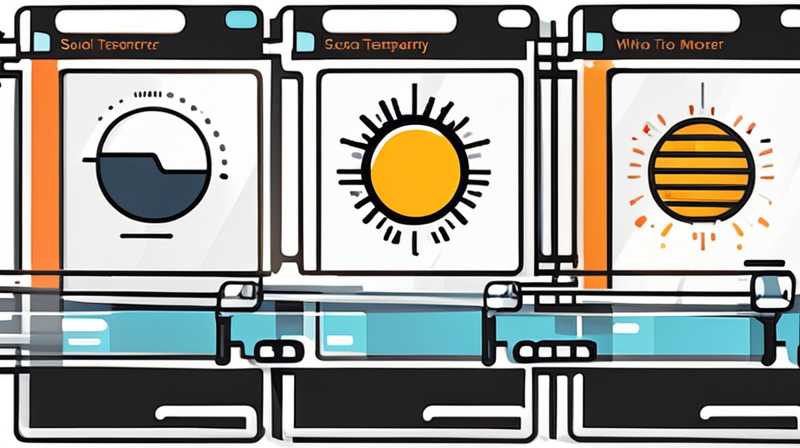
To adjust the solar temperature sensor, one must consider various critical steps and factors to ensure optimal performance and accuracy. 1. Understand the Purpose of the Solar Temperature Sensor, 2. Choose the Right Location for Installation, 3. Calibrate the Sensor Correctly, 4. Regular Maintenance is Essential. This process involves several intricate procedures and knowledge about the sensor’s functionality, placement, and periodic checks.
1. UNDERSTAND THE PURPOSE OF THE SOLAR TEMPERATURE SENSOR
The solar temperature sensor plays a vital role in monitoring and regulating temperature within various solar energy systems. It primarily measures the temperature of the solar collector or the ambient environment to ensure that the solar panels operate efficiently. Through this measurement, the system can adjust its performance to maximize energy capture and maintain safety levels.
The optimal functioning of solar thermal systems hinges on accurately gauging thermal energy. Solar temperature sensors gather invaluable data that influences the operations of hot water systems, heating, and even air conditioning units. Hence, understanding their function is the cornerstone for making practical adjustments and enhancing efficiency.
2. CHOOSE THE RIGHT LOCATION FOR INSTALLATION
Selecting the appropriate location for the solar temperature sensor is crucial for achieving accurate temperature readings. The sensor should be strategically positioned in an area where it can uniformly capture thermal energy without obstructions. This location should preferably be exposed to direct sunlight for a significant portion of the day, as this enhances its capability to record temperature variations accurately.
Additionally, one must consider potential interference from surrounding structures or foliage that may cast shadows, thus skewing the readings. A clear zone not only improves measurement accuracy but also enhances the longevity of the sensor, as it is less vulnerable to external elements.
3. CALIBRATE THE SENSOR CORRECTLY
Calibrating a solar temperature sensor is fundamental for ensuring its accuracy and reliability. This step typically involves adjusting the sensor to match a known standard or reference point. Calibration can often be accomplished using specialized equipment or by comparing the readings against a reliable thermometer for accuracy.
For anyone involved in this calibration process, it is vital to perform checks regularly, particularly following substantial temperature fluctuations, environmental changes, or alterations within the system setup. Proper calibration not only improves sensor accuracy but also helps in early detection of any malfunctions, thereby preventing costly repairs or system failures.
4. REGULAR MAINTENANCE IS ESSENTIAL
To keep the solar temperature sensor functioning at peak performance, routine maintenance is imperative. This maintenance can include inspections of the sensor casing for wear or damage, ensuring that wiring and connectors are intact, and performing software updates if the sensor is digital.
Moreover, cleaning the solar temperature sensor is also essential, as dirt and debris can affect its ability to gauge temperatures accurately. The calibration settings might need adjustments based on seasonal changes or other environmental factors, reaffirming the need for consistent monitoring and maintenance.
FREQUENTLY ASKED QUESTIONS
WHAT COMMON ISSUES CAN OCCUR WITH SOLAR TEMPERATURE SENSORS?
Common problems associated with solar temperature sensors include inaccurate readings, sensor drift, and insufficient exposure to sunlight. Environmental factors such as shading from nearby trees or structures can lead to underreporting temperatures, skewing the data collected. When a sensor experiences drift, it may require recalibration to ensure that its readings remain consistent and reliable over time. Regular maintenance checks can help to identify and rectify these issues promptly, ensuring the sensor operates effectively.
HOW DOES WEATHER AFFECT SOLAR TEMPERATURE SENSOR PERFORMANCE?
Weather conditions play a significant role in the performance of solar temperature sensors. For instance, in extreme weather conditions such as heavy snow or prolonged rain, the sensor might not be able to capture accurate readings due to insulation effects or water accumulation. This could mislead the temperature control systems, resulting in inefficient energy use. Additionally, high humidity can lead to condensation on the sensor, affecting its responsiveness. Proper placement and protective measures can help mitigate these issues and maintain performance despite variable weather patterns.
HOW OFTEN SHOULD CALIBRATION AND MAINTENANCE BE PERFORMED ON SOLAR TEMPERATURE SENSORS?
Calibration and maintenance should ideally be performed at least once a year, although more frequent checks may be warranted in environments subject to extreme conditions or significant temperature variations. During these evaluations, technicians can ensure that the sensor remains aligned with accepted standards, thus ensuring accuracy. Alongside the annual calibration, regular inspections throughout the year will help identify potential issues before they escalate, leading to longer sensor lifespan and operational efficiency.
FINAL THOUGHTS
To enhance the efficacy of solar temperature sensors, various definitive steps should be taken into consideration. 1. The sensor’s placement determines its ability to provide accurate readings, 2. Calibration procedures are pivotal to ensure the sensor’s metrics align with environmental changes, 3. Continuous monitoring and maintenance can prevent performance degradation. By initiating these practices, individuals can significantly improve the operational reliability of solar temperature sensors. Over time, following these steps not only boosts energy efficiency but also contributes to the longevity of solar heating systems, helping users leverage renewable energy to its fullest potential. This meticulous approach allows for maximizing the benefits derived from the installation of solar technology, promoting a sustainably driven lifestyle.
Original article by NenPower, If reposted, please credit the source: https://nenpower.com/blog/how-to-adjust-the-solar-temperature-sensor/


